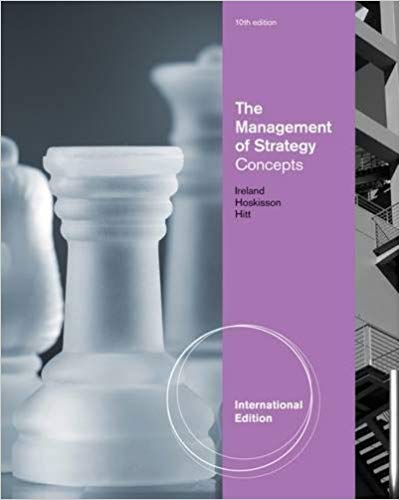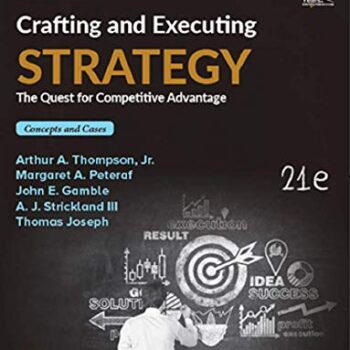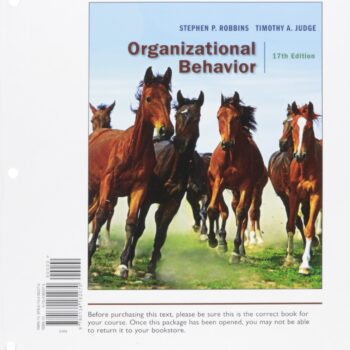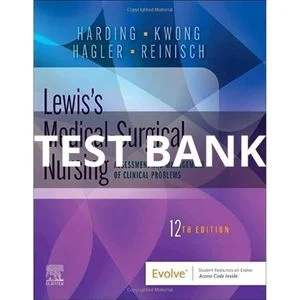
The Management of Strategy Concepts International Edition 10th Edition by R. Duane Ireland – Test Bank
Original price was: $55.00.$28.00Current price is: $28.00.
Digital item No Waiting Time Instant DownloadISBN-10: 1133584691, ISBN-13: 9781133584698
By utilizing the management concepts test bank with the 10th edition by R. Duane Ireland, learners understand strategic management concepts in a more organized manner. Test banks forward every lesson chapter and allow easier content recap of concepts through simple multi-choice questions, case studies, and true or false questions. Students are made aware of practical competitive strategies by studying the Historic Dispute Borders and Amazon case which is inclusive of strategy, innovation, and market dynamics.
Noteworthy Aspects of the Test Bank
Apart from the above-mentioned test banks helping with even the last-minute test preparations, the test bank enables one to center their preparation through competitive advantages, business development strategies, and innovation. This has been made possible as such test banks correlate with the 10th edition textbook for the student’s consideration. Important aspects like these are further elaborated within the test bank:
- Environmental Analysis: How to achieve environmental assessments to assist in strategy formulation.
- Strategy Formulation: Key components of the definition of success and plans to accomplish them.
- Strategic Competitiveness: Real-life implementation of strategies is demonstrated by Barnes & Noble and Amazon case studies.
In the business field, each student ultimately requires real-world knowledge of business management and leadership which the test bank in each chapter contains high thinking and application-based concepts, reflecting AACSB’s standards.
Advantages of Using the Test Bank
Teaching aids in the form of a test bank for this edition are expected to increase the effectiveness of learning since they provide structured and easy examination practices that resemble real ones. Below are some advantages:
- Validates Basic Ideas: Arranged so that every major heading is covered, it aids in learning by making students even more familiar with the principal concepts.
- Encourages Participation: By checking their knowledge, learners manage to participate more actively in the exams through the use of strategic management tips.
- Relates to Business Situations & Issues: Business analysis and investigative situations such as strategic competitiveness and market penetration relate well to the current market.
How This Test Bank Will Benefit You
In both cases, whether you are studying for exams or sitting in a classroom, this test bank provides a means for students to interact with the strategic management material. It’s supposed to promote self-study, and critical thinking and help learners transfer business theories to actual business situations. Further, it can serve as a tool to assist faculty members in making relevant and reliable evaluation exercises.
Summary
R. Duane Ireland’s Test Bank for The Management of Strategy Concepts International Edition not only aids students while preparing for the test but also allows them to implement concepts of strategic management in a format that is ready for test taking. It is suitable for learners who wish to do great in the business management field by learning the actual strategies which affect the real competitive business environment.
The Management of Strategy Concepts International Edition 10th Edition by R. Duane Ireland – Test Bank
Chapter 3—The Internal Environment: Resources, Capabilities, Competencies, and Competitive Advantages
TRUE/FALSE
1. The Chapter 3 Opening Case demonstrates that although conditions in the economic environment influenced Subway’s success, how Subway used its resources and capabilities also influenced that success.
ANS: T PTS: 1 DIF: Easy OBJ: Application
NOT: AACSB: Business Knowledge & Analytical Skills | Management: Creation of Value | Dierdorff & Rubin: Managing strategy & innovation | Bloom: Application
2. People are a critical resource for helping organizations learn how to continuously innovate.
ANS: T PTS: 1 DIF: Easy OBJ: Comprehension
NOT:AACSB: Business Knowledge & Analytical Skills | Management: Creation of Value | Dierdorff & Rubin: Managing human capital | Bloom: Comprehension
3. Firms should seek to continually develop new core competencies because all core competencies have limited life spans.
ANS: T PTS: 1 DIF: Easy OBJ: Comprehension
NOT:AACSB: Business Knowledge & Analytical Skills | Management: Creation of Value | Dierdorff & Rubin: Strategic & systems skills | Bloom: Comprehension
4. The sustainability of a competitive advantage depends upon the rate of obsolescence of the core competence, the availability of substitutes for the core competence, and the imitability of the core competence.
ANS: T PTS: 1 DIF: Medium OBJ: Knowledge
NOT:AACSB: Business Knowledge & Analytical Skills | Management: Creation of Value | Dierdorff & Rubin: Strategic & systems skills | Bloom: Knowledge
5. Firms achieve strategic competitiveness and earn above-average returns by acquiring, bundling, and leveraging their resources to take advantage of opportunities in the external environment in ways that create value for customers.
ANS: T PTS: 1 DIF: Easy OBJ: Knowledge
NOT:AACSB: Business Knowledge & Analytical Skills | Management: Creation of Value | Dierdorff & Rubin: Strategic & systems skills | Bloom: Knowledge
6. Analyzing the internal environment enables a firm to determine what it might do by identifying what opportunities and threats exist.
ANS: F PTS: 1 DIF: Hard OBJ: Comprehension
NOT:AACSB: Business Knowledge & Analytical Skills | Management: Creation of Value | Dierdorff & Rubin: Strategic & systems skills | Bloom: Comprehension
7. Analyzing the internal environment enables a firm to determine what it can do by identifying resources, capabilities, and core competencies in the internal organization.
ANS: T PTS: 1 DIF: Medium OBJ: Comprehension
NOT:AACSB: Business Knowledge & Analytical Skills | Management: Creation of Value | Dierdorff & Rubin: Strategic & systems skills | Bloom: Comprehension
8. Given enough time, any firm’s competitive advantage can be imitated by its competitors.
ANS: T PTS: 1 DIF: Easy OBJ: Knowledge
NOT: AACSB: Business Knowledge & Analytical Skills | Management: Strategy | Dierdorff & Rubin: Strategic & systems skills | Bloom: Knowledge
9. Understanding how to leverage the firm’s unique bundle of resources and capabilities is a key outcome decision-makers seek when analyzing the internal organization.
ANS: T PTS: 1 DIF: Medium OBJ: Comprehension
NOT: AACSB: Business Knowledge & Analytical Skills | Management: Strategy | Dierdorff & Rubin: Strategic & systems skills | Bloom: Comprehension
10. In today’s global economy, traditional factors such as labor costs, access to financial resources and raw materials, and protected or regulated markets are less likely to become core competencies and possibly competitive advantages.
ANS: T PTS: 1 DIF: Easy OBJ: Knowledge
NOT:AACSB: Multicultural & Diversity | Management: Creation of Value | Dierdorff & Rubin: Strategic & systems skills | Bloom: Knowledge
11. A global mindset is free of the assumptions of a single country, culture, or context.
ANS: T PTS: 1 DIF: Easy OBJ: Knowledge
NOT: AACSB: Multicultural & Diversity | Management: Strategy | Dierdorff & Rubin: Strategic & systems skills | Bloom: Knowledge
12. Resources are the source of capabilities, some of which lead to the development of core competencies; in turn, some core competencies may lead to competitive advantage.
ANS: T PTS: 1 DIF: Easy OBJ: Knowledge
NOT:AACSB: Business Knowledge & Analytical Skills | Management: Strategy | Dierdorff & Rubin: Knowledge of general business functions | Bloom: Knowledge
13. Value is measured by the variable and fixed costs associated with the production and marketing of a particular product compared with the revenue and profits the product generates.
ANS: F PTS: 1 DIF: Medium OBJ: Comprehension
NOT: AACSB: Business Knowledge & Analytical Skills | Management: Creation of Value | Dierdorff & Rubin: Managing strategy & innovation | Bloom: Comprehension
14. Value is created when firms innovately bundle and leverage their resources to form capabilities and core competencies.
ANS: T PTS: 1 DIF: Easy OBJ: Knowledge
NOT: AACSB: Business Knowledge & Analytical Skills | Management: Creation of Value | Dierdorff & Rubin: Managing strategy & innovation | Bloom: Knowledge
15. Creating customer value is the source of the firm’s potential to earn above-average returns.
ANS: T PTS: 1 DIF: Easy OBJ: Comprehension
NOT:AACSB: Business Knowledge & Analytical Skills | Management: Creation of Value | Dierdorff & Rubin: Strategic & systems skills | Bloom: Comprehension






